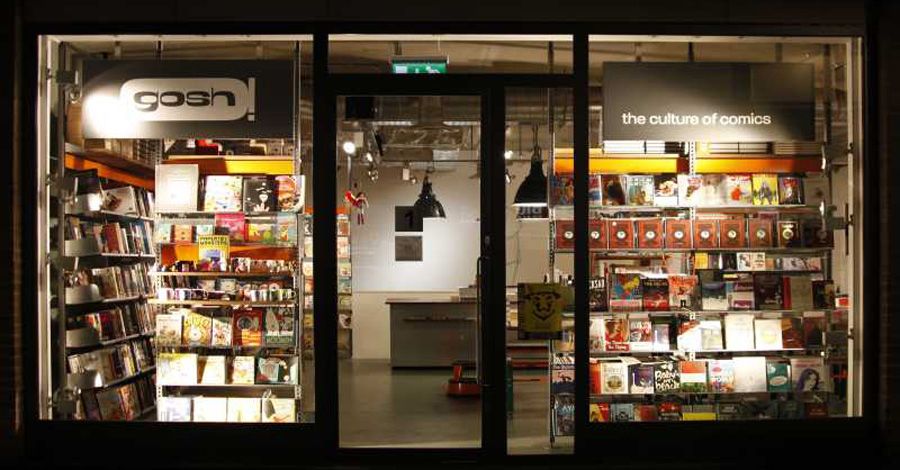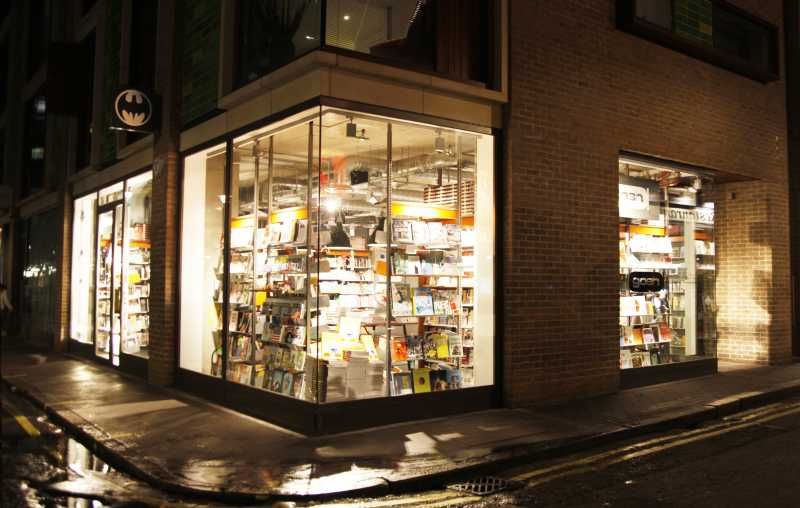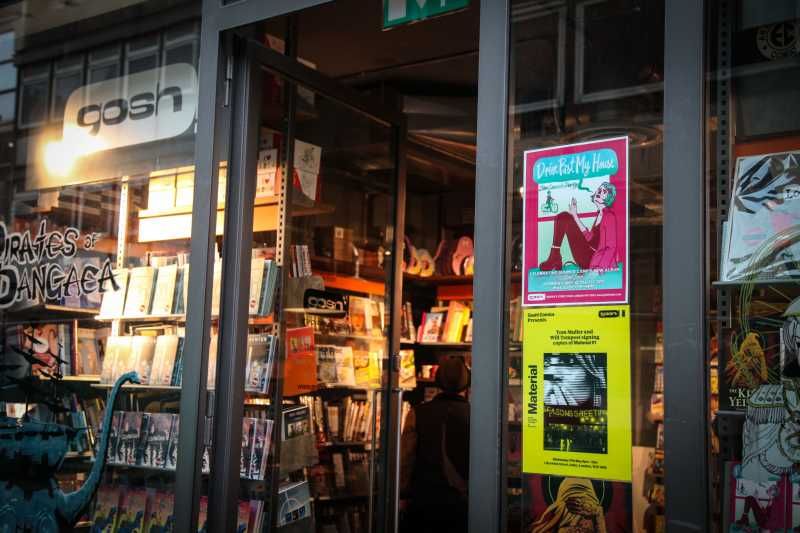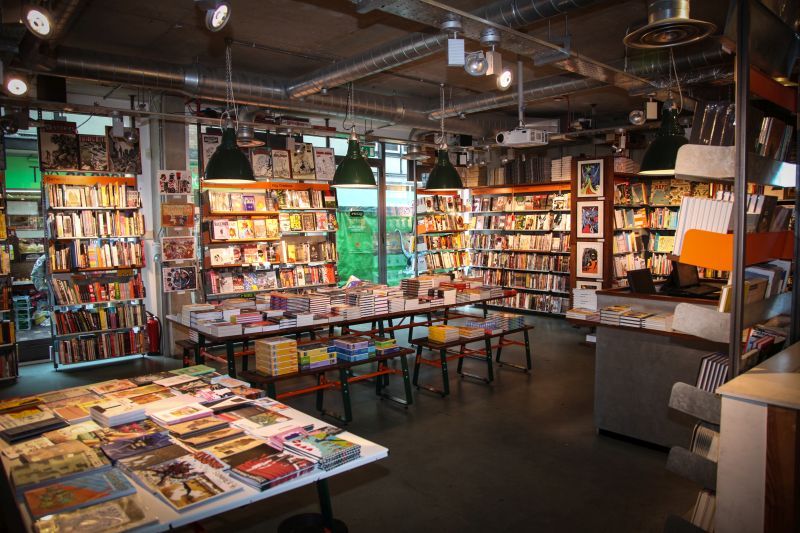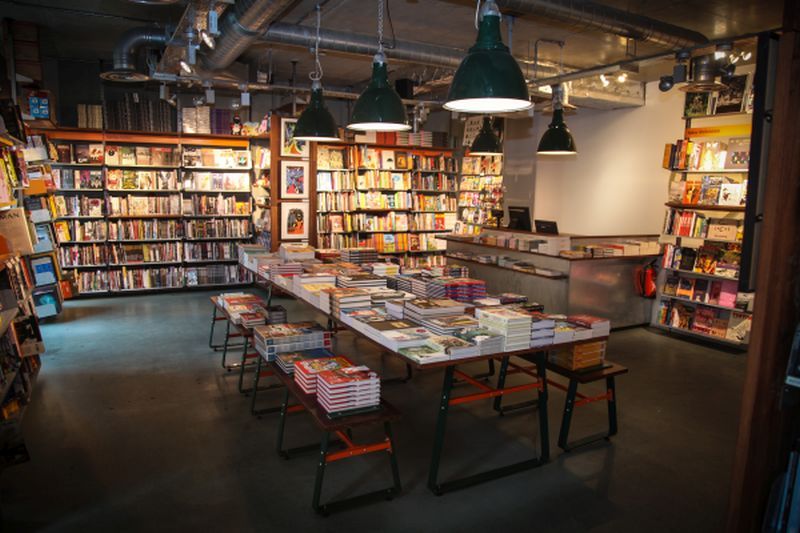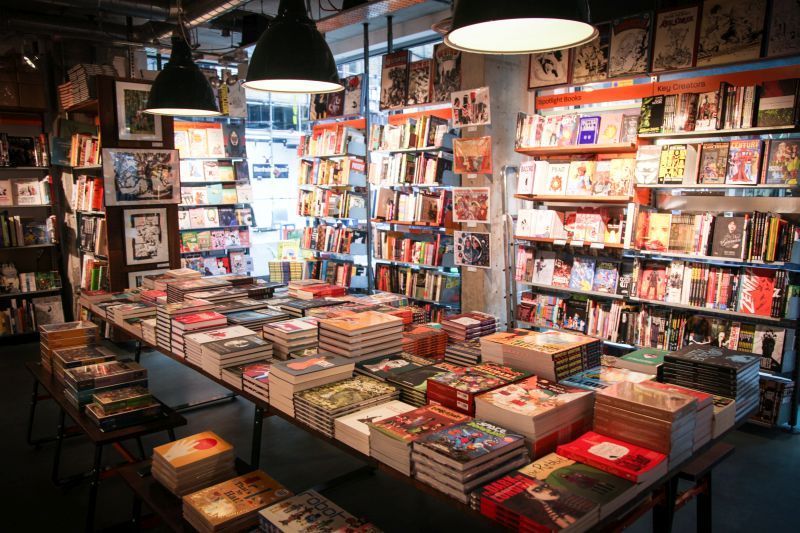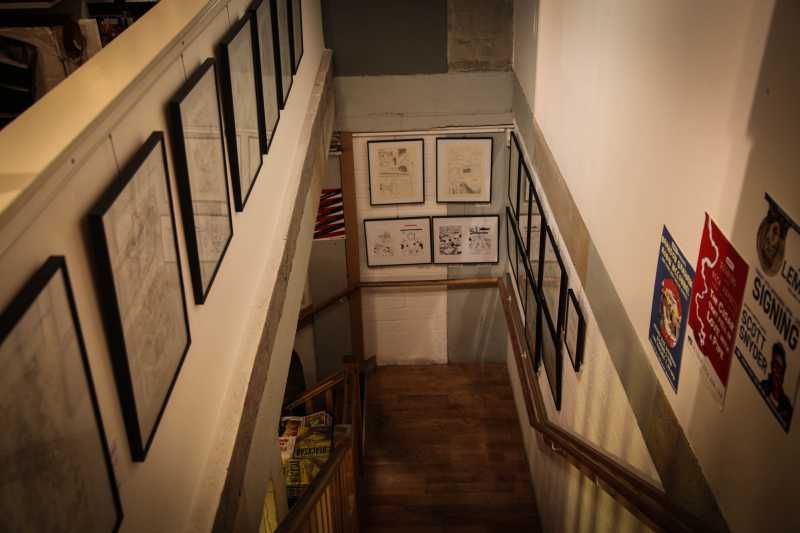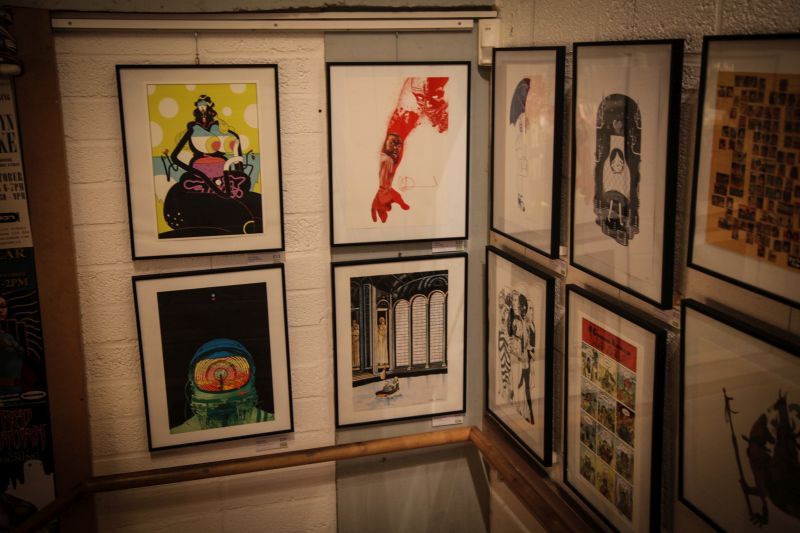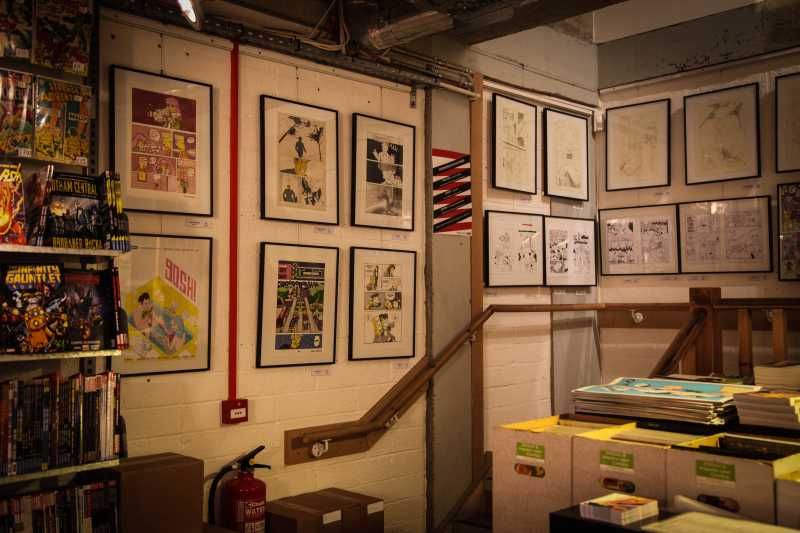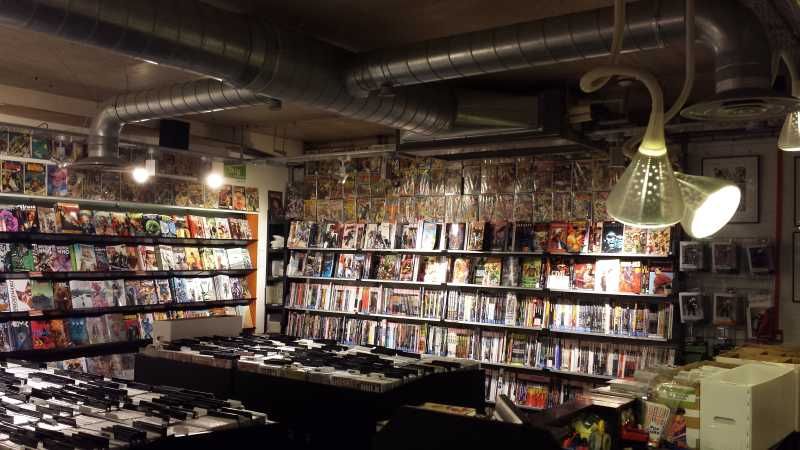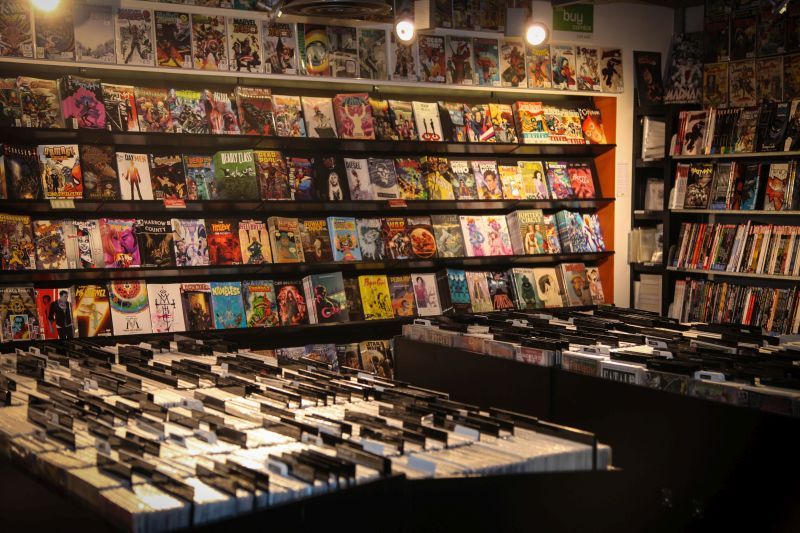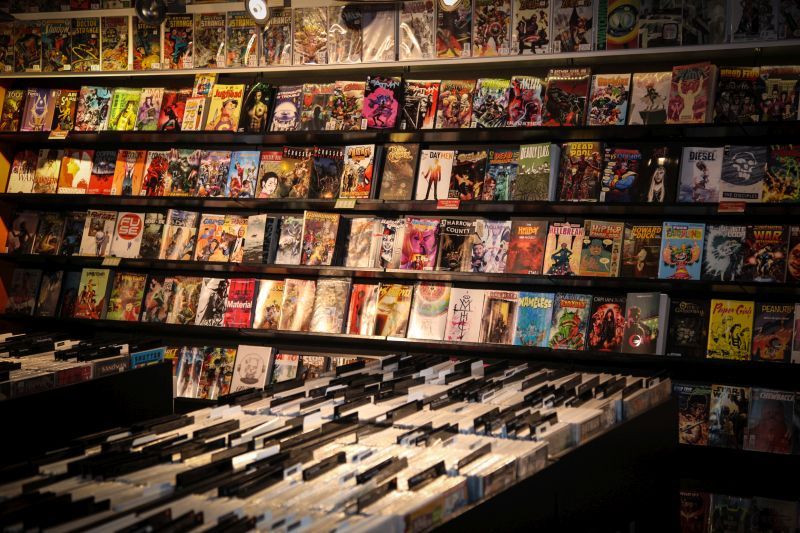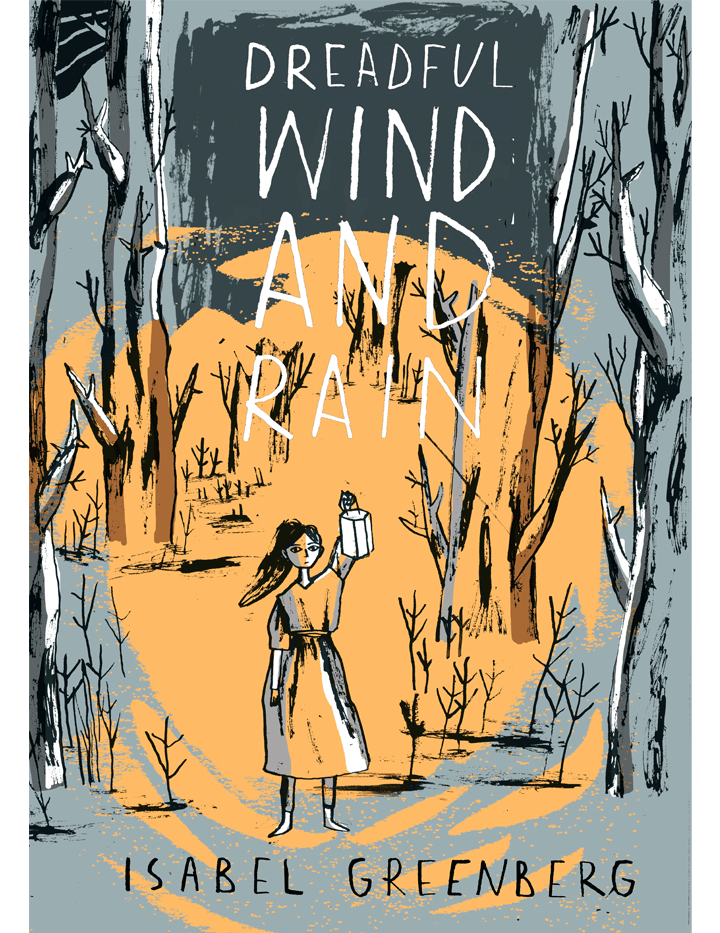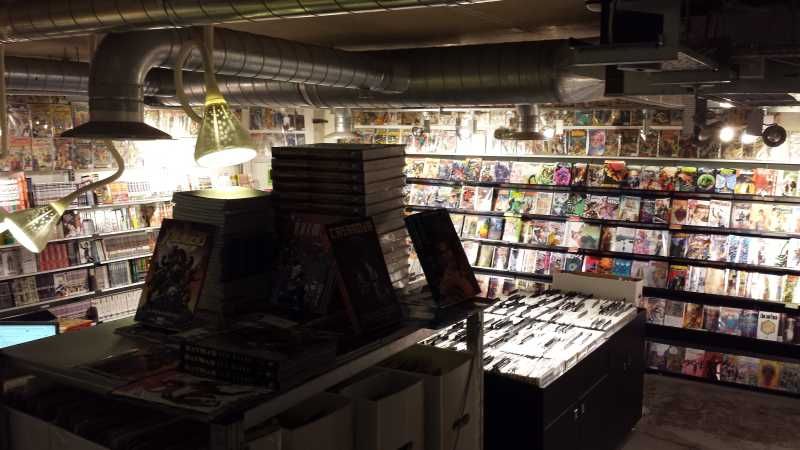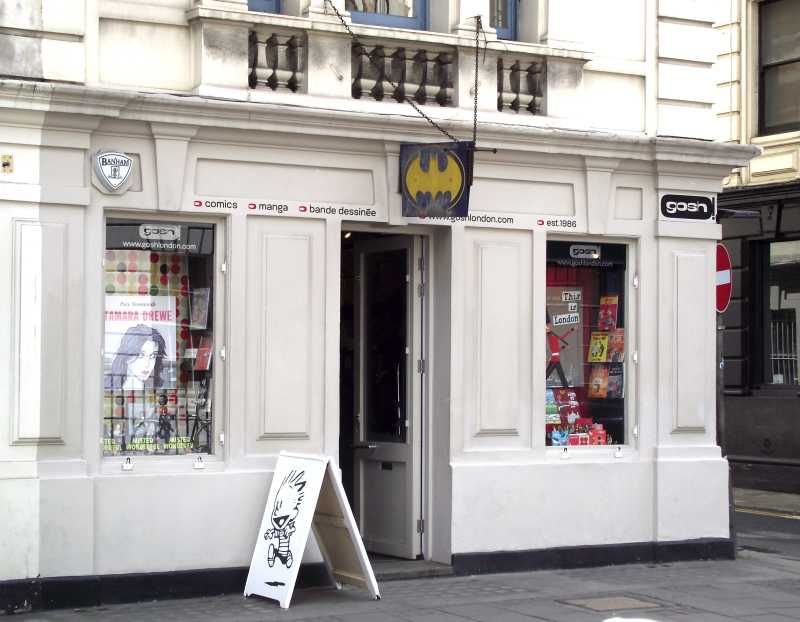Welcome to Store Tour, ROBOT 6’s weekly exploration of comics shops, and the people who run them. Each Sunday we feature a different store, and also get to know the person behind the register.
To discover a comic store in your area, visit FindAComicShop.com
This week’s store is Gosh! Comics, located at 1 Berwick St. in London, England. We spoke with manager Andrew Salmond.
ROBOT 6: What's the secret origin of your store?
Andrew Salmond: The store was started back in 1986 by Josh Palmano, who is still the owner (and still puts in a full week at the shop). He had worked in comics in one form or another, from dealer stalls at shows to retail outlets, since he was 13. When he was 18 he started up Gosh! in the unit it operated from opposite the British Museum right up until 2011. At the time that area, as well as having the kind of crowd pull that the museum attracted, was known for its range of booksellers, particularly of the antiquarian variety. So Gosh! was able to find an audience there, and has happily traded successfully ever since. As for the name, there’s no great story to it beyond it being a peppy, fun, British-sounding name for a comic shop. Short and snappy, and suited an exclamation point.
Why did you decide to get into comics retailing?
I’ve been a lifelong comics fan, from random purchases on spinner racks at the local dairy (New Zealand speak for a convenience store), to a standing order at our local bookshop, to frequenting a comic shop once I got to university. I’d been a bit of a Marvel junkie all through my youth, with a foray into the speculator side of things in my mid-teens when I’d be mail-ordering stuff from the American Entertainment and New England Comics ads. Once I hit university I started reading more expansively, introduced to a lot of new stuff through the .comics Usenet groups (this is back in 1991), and having the range of a decent comic shop available. So my reading and knowledge base were pretty broad, and I was devouring any histories or academic works I could find. That set me up well as I was finishing up at university without any idea of what I was going to do afterward, when the shop (Comics Compulsion -- now called Graphic - in Wellington, New Zealand) needed a new staff member, and knew that I knew my stuff. So I took a job there and haven’t looked back. Worked there for five years before relocating to the U.K., where I intended to travel for a couple of years and then head back to New Zealand. Got a job at Gosh! doing mail order from a cold email that hit at just the right time, and 15 years later I’m still here managing the joint!
Do you have a philosophy or strategy to retailing? Has it evolved from when you first started?
My main philosophy has always been a customer-centered focus to retail. Good retail is about friendly customer service, comprehensive knowledge and the ability to sell your product. Excellent retail is about empathy, about putting yourself in the shoes of your customer and attempting to help them based on their needs and what they might expect of the experience. It’s about knowing when to sell and when to step back, and responding to their questions and concerns in a manner which shows that you’re considering their point of view. I’ve no time for arrogance or impatience in customer service. If you’re the expert, be secure in yourself that you’re the expert; don’t feel the need to rub people’s faces in it, or scoff at someone’s lack of knowledge. I only mention this, because of course the traditional comics seller stereotype is awash with it. Stores on the whole are much better than they were with this kind of thing, but those guys are still out there.
And then of course effective comics retailing is about exploiting that thing which allows us to distinguish ourselves from other outlets that sell comics and graphic novels: knowledge. It’s important to have a breadth and depth of knowledge that can help you find the right choice for each customer. Over time this has become something which is ever more important, the only real footing we have as a means of competing with online sales and large chains offering deep discounts. Having the ability to tap the general interests of a customer in order to find the right book to keep them enthused (or enthuse them in the first place) is vital. And again, empathy is key: Find what they will like, not necessarily what you want to sell them (though the two often dovetail nicely). Thankfully in the comics market today it’s easier than ever, with the range of material available broadening all the time. There is a market of non-comics reading people out there which is massive, and the more we can tap that the better.
Tell me about the layout of your store. How did you work it out?
We moved into our current premises after 25 years in a much smaller unit near the British Museum, and the combination of doubling our floor space as well as taking over a completely empty unit allowed us to create a layout from scratch. We did this in collaboration with designer Callum Lumsden of Lumsden Design, who had previously worked on the bookstores for the Tate Modern and the British Museum, among other projects. We wanted to do more than just dump our old fixtures and fittings into a new location, so we figured it was worth the investment!
Gosh! is always striving to bring comics to a new audience, and so our upstairs space has been designed to create an attractive bookstore feel, spotlighting graphic novels that we feel reach out beyond just the traditional comics audience. A central feature table greets customers as they enter the store, stacked with a diverse range of releases focusing particularly on contemporary fiction, biography, reportage and young-adult graphic novel titles. Around the store categories are separated into Crime, European, Classics, Genre (science fiction, fantasy and horror titles), General Fiction, Biography and Non-Fiction. Our all-ages graphic novels are also located here, alongside our curated selection of children’s books. Upstairs also features illustrative gift books, a section of animation-related titles, and a selection of reference and instructional titles, as well as our expansive collection of self-published titles.
Our downstairs is designed as a classic comic shop, albeit a pleasant, light, well-organized one. As a customer descends the stairs, an impact wall of new releases -- both periodicals and trades -- jumps out from the back wall. The central floor is dominated by back-issue units, as is the upper-wall space, but along the right is our superhero trade section, alphabetized by title, with two rows of spotlight face-out titles running the length of the shelving. On the wall opposite are three bays of manga, and a final bay of classic strip collections.
We took a bit of grief for putting the superhero stuff in the basement when we moved, including accusations of sidelining or ghettoizing that material, but it’s worked out fine. The audience for new releases knows where to find it, and we still love it and happily communicate our love of it. In the meantime we’re regularly drawing a new audience into the medium, which should ultimately be the goal of any decent store.
What are your current bestsellers? What are your favorites that deserve to sell better at your store?
In terms of new comics, obviously the top Marvel and DC titles still do well (Avengers, Amazing Spider-Man, Batman and so on), as do the Image titles you might expect (Saga, The Walking Dead, etc.). We do very well out of the odd indie periodicals that are still published, such as Berlin and Optic Nerve. Our audience is very creator-focused (and predominantly writers), and we can reliably copy orders across titles for certain writers and artists, which means books like The Fade Out, Paper Girls and Black Magic hit the ground running, sales-wise.
In terms of books, we do very well with the Image line (Saga is one of our strongest-selling trade series ever), the First Second YA titles (such as Battling Boy, Anya’s Ghost and This One Summer), the classic Vertigo books and biography and nonfiction titles such as Persepolis, Maus, Palestine, etc. Superhero trade sales are strong, particularly on Deadpool, Ms. Marvel, Batman and the various Marvel event titles, which Secret Wars has definitely given a collective boost to. We also do a line of exclusive bookplated titles to give a push to books we believe in, and they traditionally do very well, as do titles we support with events.
In terms of titles I wish would do better, Stray Bullets is one of my all-time favorite series, and happily its recent return didn’t skip a beat on the quality front. Don’t get me wrong, it does respectably enough for us, but I wish EVERYONE was reading it. I’d like to see Manifest Destiny catch more of an audience as well, as it’s a lot of fun if you’re into frontier fiction with a side of horror.
What is your customer base like? How has it changed over time?
Varied, and has been for a long time. The whole philosophy of the shop has always been to create a clean, welcoming atmosphere, and that has long paid dividends with a diverse customer base. Obviously with the increasing range of graphic novels available and the coverage they receive, we’ve seen an influx of people curious about the medium, which means we get the same kind of demographic as pretty much any decent bookstore you might wander into, particularly since going into our new premises.
How do you reach out to new customers? How do you advertise? Do you have a discount or loyalty program for new customers?
We largely keep things grassroots. We try to get coverage in mainstream press wherever we can, and plan and publicise our events program in such a way as to bring new people to the shop as often as possible. We have tried paid advertising in the past, and just found it to be ineffective for the price. We do get involved with shows such as Thought Bubble and podcasts such as SILENCE! as well to get our name out there.
We don’t have a loyalty scheme, per se, but we do offer a student discount, and offer a discount in partnership with the Prince Charles Cinema (something of an institution in London’s West End).
How do you feel your online presence, such as social media on Facebook, Twitter and Tumblr, supports or supplements your store?
Hugely. We have a good-sized Twitter following for general publicity and announcements, use Facebook largely to administer our events, and have a weekly blog where we highlight the notable releases for the week, as well as all our events and exclusives. In the past eight years or so, social media has actually become one of our main tools for finding new audiences and promoting the store worldwide. We try to maintain a civil presence, not shoving stuff down people’s throats or shilling products we don’t believe in, and keep a fairly light, conversational tone. In all, for a store that’s always been reliant on grassroots publicity, it’s been a real gift.
Do you have events or any kind of programming, such as signings? How is it coordinating those?
We do numerous events throughout the year, usually at least one or two a week. These range from signings and after-hours launch parties, through to children’s activity tables and talks and presentations. We host both local and international guests, and also host a number of regular monthly groups: Process, a discussion group for comics creators and those with an interest in the craft; Comics Gosh!p, our monthly reading group; Capers, a superhero-dedicated discussion group; Laydeez Do Comics, an extremely popular women-led graphic novel forum; and a regular Drink’n’Draw evening featuring special guest artists held in association with the lovely folks at Broken Frontier.
We try to keep a nice varied mix of events turning over to attract different audiences and avoid event fatigue, and of course certain times of year are busier than others. We also tend to keep things to a minimum through December and January to avoid clashing with our busiest and slowest times of year. There’s certainly plenty to keep track of, from drinks provision to staffing to publicity to stock purchasing and so on, but we keep things running fairly smoothly by making sure there’s good communication and logistics. In one word: spreadsheets.
Does your store attend conventions? Does it benefit from them?
Not very often, as we’re fairly tightly staffed for our needs, and taking people away for shows adds unwanted stress. We don’t have in place the kind of well-oiled show-touring logistics that some stores have, and honestly have other priorities we want to put our resources into. We do OK commercially at the shows we do attend, but if we do them it’s generally for outreach purposes so that we can communicate something about our stock mix, or try and find new audiences. They’re valuable networking exercises as well, of course, though most of that happens in the bar later anyway.
You've done some publishing, namely Isabel Greenberg's Dreadful Wind and Rain, and I believe an upcoming zine. How did that come about? What made you take the plunge into that arena?
We were keen to start doing the occasional limited-run exclusive title just as a nice project to support creators whose work we really love. We already have ties to both Knockabout Books and Breakdown Press, but wanted to do some pieces for the store itself. The opportunity came up to publish the book with Isabel in conjunction with Cecil Sharp House, who featured the work as part of an exhibition with the English Folk Dance and Song Society. After the success of that, we’ve also published an extremely limited run work-in-progress preview of Stephen Collins’ upcoming book Bad Likeness, and a new edition of Matt Taylor’s self-published title The Great Salt Lake (which was a sellout success at the 2014 Thought Bubble festival). We also do a number of exclusive prints with creators we like, from cheap and cheerful digital prints through to limited run screenprints and Giclées. All are of course available through our webstore (plug plug).
What do you see as the biggest challenge in the comics industry today that particularly impacts your store? And what is the industry's biggest asset that is helping you be successful?
Short-term thinking in the direct market always terrifies me, having worked through the '90s crash. Though I would say that despite the proliferation of variants, events and relaunches, the audience seems pretty committed still, and lord knows the books are of a higher general level of quality than they were then. There’s also a greater push to embrace a more diverse market, both in content and audience, so hopefully we can create a healthy baseline to catch us in the event of a fall.
But as ever, the greatest challenge is acceptance. Getting ourselves out there and making a song and dance for the general public to create a mass market we can all benefit from. We need to continue to embrace diversity, make good product and learn how to sell it to people who don’t know they want it. At the end of the day if Scholastic can sell 2 million copies of Smile, then there’s a healthy future for us yet.
I should also add that one of our greatest assets, and one for the industry in general, is the commitment and passion so many people who work in it have for the medium. I know all the horror stories and have experienced plenty, but that overlooks all those people who bring their love and enthusiasm for comics to the table every day in a positive, professional manner. I’ve been lucky enough to work with terrific people throughout my career in comics, and even luckier to be the manager of many who have collectively been responsible for our success. I’ve been nattering on here, but I’d be remiss not to mention what a wonderful, smart, talented bunch of people I’ve had the privilege to work with over the years. Good folks.
With all of the people that come through your store, I imagine you must have some great stories. What is the funniest or most memorable moment you've seen in your store?
I remember not long after I started at Gosh! being at the counter putting a mail-order transaction through, and catching a customer approaching in my periphery. I looked up to say hi, and it was Paul McCartney clutching a few trades. He was looking to buy for his son, and had no idea what to get, so we had a chat about this and that and I sorted him out with a few recommendations. I'm damned if I can remember everything he bought. I think in the end it was a selection of three or four Vertigo titles, mainly, including The Sandman: Preludes & Nocturnes. Really nice fella. For a guy from a beach town in New Zealand still fairly fresh to London, that was kind of mind-blowing.
And of course there was the time in the old shop that the ground floor ceiling fell in and I was convinced for a few seconds that I was going to die. Good times! (I so wish I still had the CCTV footage of that.)
Anything coming up at Gosh! that's a good excuse for someone to stop by?
Always. Apart from the aforementioned regular events, we’ve got a few good events coming up: a launch party for the Wolf trade paperback with Ales Kot, Tom Muller and special guest Will Tempest (Material); Star Wars Day with Kieron Gillen and Jedi Knight JAKe (How to Speak Droid/Wookiee); a kids comics workshop with Metaphrog (The Red Shoes and Other Stories); a Red Thorn #1 signing with David Baillie andMeghan Hetrick; and a Giant Days trade paperback launch party with John Allison. That takes us through to Christmas, then things will start winding up again in the New Year with plenty of exciting stuff in the works!
If you’d like to see your store featured here on Robot 6, email us.

